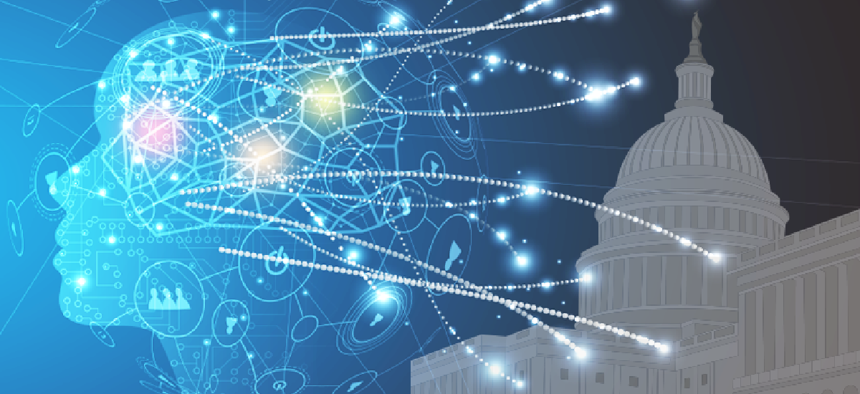Federal AI: The time is now

As the expectations of citizens continue to grow, agencies must accelerate their plans to develop more commercial-like, citizen-centric services, and AI will be a key driver.
In a recent executive order, Accelerating America’s Leadership in Artificial Intelligence, the Trump administration directs federal agencies to determine how AI can be used to advance their missions. Already, the technology is evolving faster than many anticipated. We are now at an inflection point where technical advances and growing citizen expectations create a compelling case for the implementation of AI capabilities across government. With AI effectively and efficiently reinventing processes and interactions in the private sector, it’s time for agencies to rethink what is possible and reimagine new ways to be even more mission-focused and citizen-centric.
We live in a world where companies relentlessly compete to provide more choice and greater convenience. The idea that any request should take weeks or months to process is alien to today's consumer. Most have the same expectations for federal agencies, with Accenture research finding that 85 percent of citizens say that they expect government digital services to equal or surpass commercial versions. Additionally, Gartner predicts that by 2020 customers will manage 85 percent of their relationships with companies without interacting with a human.
As the expectations of citizens continue to grow, agencies must accelerate their plans to develop more commercial-like, citizen-centric services, and AI will be a key driver.
AI is here today
With each evolutionary cycle of these often cloud-native AI technologies, large vendors, startups and open source communities deliver new capabilities that reduce the need to create custom solutions. This environment results in more ready-to-deploy solutions, better performance and lower cost through scalable cloud offerings.
In a world immersed with new technology, the rise of AI-powered voice assistant technology is an especially promising example of this trend. According to a recent report, almost a third of consumers (32 percent) now own a smart speaker, with 76 percent reporting their use has increased in the past year. A full 71 percent noted that they use the device at least once per day. Counting smartphones, we now have over one billion devices worldwide with voice assistant capabilities. AI-powered technologies like voice assistants will have a profound impact on citizen services in the future.
AI is enabling a paradigm shift where machines adapt to humans -- as responding to voice commands illustrates. Historically, we have employed time-consuming workarounds and adapted processes to overcome the constraints of our technical capabilities. Given the rapid advances in computing power and machine learning tools, we can increasingly use AI-powered solutions to reimagine business processes and user experiences unencumbered by these limitations.
Agencies can use machine learning and natural language analytics to reimagine claims processing, for example, saving time and improving accuracy. These tools can highlight the most relevant portions of each case to help adjudicators accelerate their review and reduce existing backlogs.
Getting started on your AI journey
While some fear AI’s disruptive impact, there is strong evidence to show that humans and machines can work together to produce better outcomes than either could do separately. In a recent Harvard study, pathologists and AI technology were pitted against each other to determine which could identify cancer cells more accurately. The AI solution identified the cells with 92 percent accuracy. Interestingly, the pathologists did better, achieving 96 percent accuracy. However, when the pathologist and AI collaborated on the task, the accuracy rate jumped to 99.5 percent.
The Harvard case demonstrates that AI is not only about automating tasks but augmenting existing human capabilities. As Paul Daugherty notes in his book, "Human + Machine: Reimagining Work in the Age of AI," the "collaboration between workers and smart machines is leading to the reinvention of many traditional processes." Within this process change, we see a transformation of roles within the federal government that will allow employees to offload more administrative tasks and focus more of their efforts on fulfilling the mission, aligning themselves with a greater sense of purpose and making work fundamentally more rewarding.
Our research shows that agency leaders already anticipate working with AI. In a recent survey, 82 percent of federal executives agreed that within the next two years, “AI will work next to humans in my organization, as a co-worker, collaborator, and trusted advisor.” Additionally, in a forthcoming report, 74 percent of federal workers indicated they believe that it will be somewhat or very important for them to develop skills to work with AI.
Finally, federal agencies have a significant role to play in the emergence of responsible AI, given their position in the lives of citizens. As a starting point, it’s imperative that AI is free of bias, transparent and explainable. Sustainable adoption requires the trust of both citizens and workers, which can be achieved by demonstrating the safeguards put in place to govern the fair, ethical use of AI in decision-making.
AI will be fundamental to meeting rising citizen expectations and future budget constraints. Fortunately, the technology is advancing rapidly with many applications ready to have a real-world impact on federal operations today.
NEXT STORY: What Hackers Have in Store for 2019





